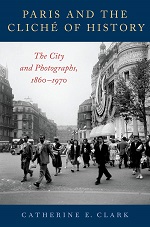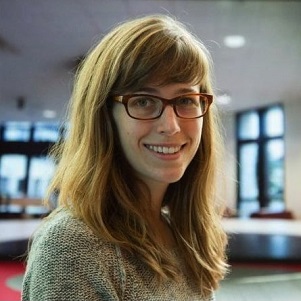Posts com a Tag ‘História de Paris’
Paris and The Cliché of History: The City and Photographs, 1860-1970 – CLARK (THT)
Catherine Clarke. Foto: Comparative Media Studies – MIT /
 CLARK, Catherine E.. Paris and The Cliché of History: The City and Photographs, 1860-1970. New York: Oxford University Press, 2018. 328p. Resenha de: KERLEY, Lela F. The History Teacher, v.52, n.4, p.717-718, ago., 2019.
CLARK, Catherine E.. Paris and The Cliché of History: The City and Photographs, 1860-1970. New York: Oxford University Press, 2018. 328p. Resenha de: KERLEY, Lela F. The History Teacher, v.52, n.4, p.717-718, ago., 2019.
In this social history of photography, Catherine E. Clark demonstrates that the visual discourses and methodologies used to document the historical and urban landscape of France’s capital were constantly being reconceptualized over the course of the nineteenth and twentieth centuries. Journalists, curators, city officials, amateur and professional photographers, and societies contributed to a history of Paris that was inextricably linked with a history of photography. Woven into the book’s narrative is an institutional history of the Bibliothèque historique, the Musée Carnavalet, the Fédération nationale d’achats des cadres (FNAC), and the Vidéothèque de Paris vis-à-vis the local/national initiatives and photography contests they sponsored that punctuated, but also commemorated, larger historical shifts such as Haussmannization, the Occupation and Liberation of Paris, Americanization, and “les trente glorieuses.” By examining photographic collections spawned by these events, Clark presents a colorful portrait of how the French, but also foreign tourists, saw the city and interpreted its past, present, and future amid urban transformation.
The book begins with the overarching question: What is the history of preserving, writing, exhibiting, theorizing, and imagining the history of Paris photographically? (p. 1). These concerns are deftly addressed together in each of the five chapters, tracing the way in which understandings of the photographic image—its purpose, function, and the history it purported to communicate— shaped and were shaped by commercial and non-commercial interests. Building on earlier scholarship produced by cultural theorists such as Guy DeBord, Roland Barthes, and Susan Sontag, who view visual spectacle as a metaphor for changing relationships within the city, Clark adds her own original interpretation, arguing that the production, preservation, and use of photographs influenced, informed, and determined how people thought about Paris as a museum city and engaged with it physically (p. 216).
Chapter 1 focuses on Haussmannization, a city works project that precipitated the first major effort to document the destruction of “Vieux Paris.” Through the process of modernization, municipal authorities, archivists, and museum directors slowly shifted their reliance on more traditional forms of visual historical documentation (e.g., maps, paintings, and sketches) to the photograph as they discovered its inherent value as a piece of “objective” historical evidence. A method of scientific visual history, as Chapter 2 illustrates, came to the fore and introduced new “modes of seeing history” by the turn of the century (p. 2). Now considered “an objective eyewitness to history,” the photograph gave rise to photo-histories that were more didactic in their narration of historic events, providing explanations to viewers of how they should interpret the image.
Chapter 3 shows how the Occupation and Liberation of Paris engendered different “mode[s] of reading the photo” (p. 3). Through the practice of repicturing, heavily censored yet seemingly innocent photo-histories of famous Parisian landmarks kept the French revolutionary tradition alive by including a combination of visual forms that would recall acts of resistance embedded in viewers’ historical imagination. Seven years later, the Bimillénaire de Paris of 1951 reduced the photographic image to a visual cliché, and the subjects who figured in those pictures to typologies. Celebrating the last 2,000 years of French history, the Bimillénaire assumed a political bent and “appealed to those who sought to promote Paris as the commercial capital of Europe, backed by centuries of culture and history, not as an intellectual capital of revolutionary political thought” (p. 132). Chapter 4’s discussion of the city’s attempt to promote Paris as modern and futuristic in promotional posters, traveling exhibits, and magazines depended upon older models of seeing history and reading representations that attested to both change and continuity. Chapter 5 examines “C’était Paris en 1970,” a photo contest commissioned by the store FNAC that involved over 15,000 amateur photographers photographing everyday life within Paris (p. 174). Yet the very title of the contest underscored more of what had changed in the last 110 years of photographic documentation and collection rather than what remained the same. Whereas the historical value of a nineteenth-century photograph had taken decades to appreciate, historical value was immediately conferred the moment the photo was taken by the last third of the twentieth century.
This well-researched book will be of interest for those studying urban history, the history of Modern France, visual culture, and archival management. With over eighty illustrations, there is no lack of material with which to engage students. Its slim size and readily accessible prose is appropriate for both upperlevel undergraduates and graduate students, as it complements more in-depth theoretical discussions and debates on the politics of memory and the effects of technology in shaping national and local identities. Its interdisciplinary treatment of photography, publishing, the history of Paris, and the recording, preservation, and promotion of that history makes this an intriguing and indispensable text.
Lela F. Kerley – Ocala, Florida.
[IF]História de duas cidades: Paris, Londres e o nascimento da cidade moderna | Jonathan Conlin
O livro “História de duas cidades: Paris, Londres e o nascimento da cidade moderna”, de Jonathan Conlin, é fascinante. O historiador americano, radicado na Grã-Bretanha e reconhecido por pesquisas na área de museologia, utiliza uma abordagem que combina erudição, criatividade, pesquisa documental e imaginação histórica para analisar o desenvolvimento das cidades modernas a partir da Paris e da Londres dos séculos XVIII e XIX – ou seja, a chance de sermos tomados de surpresa nos mantêm alertas ao longo do livro.
A obra é dividida em seis capítulos – elaborados de modo a nos darem a sensação de um passeio – sobre a Paris e a Londres dos séculos XVIII e XIX. A partir de periódicos, documentos oficiais, memórias, relatos de viajantes, ilustrações, obras literárias, entre outros, Conlin analisa a relação entre metrópole, arquitetura e indivíduos, esquadrinhando seis distintos territórios da vida urbana parisiense e londrina: o lar, a rua, o restaurante, o music hall, o submundo noturno e o cemitério. Leia Mais


